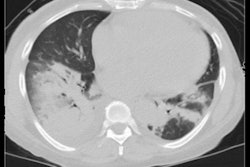Nuclear medicine specialist Dr. Rick Wray and colleagues at Memorial Sloan Kettering Cancer Center performed a retrospective review of patients diagnosed with COVID-19 who had FDG-PET/CT scans for routine cancer care between March 1, 2020, and April 30, 2020, during the height of the pandemic in New York City. They reviewed the PET/CT scans for findings suspicious for COVID-19 and noted location, FDG avidity (maximum standardized uptake value [SUVmax]), CT morphology, and time interval between PET/CT and reverse transcription polymerase chain reaction (RT-PCR).
Thirteen out of 31 patients had positive PET/CT scans, yielding a detection rate of 41.9%, the researchers found. Patients with positive scans had significantly higher rates of symptomatic COVID-19 infection (77% vs. 28%, p = 0.01) and hospitalizations (46% vs. 0%, p = 0.002) compared with patients with negative scans.
Eleven of those 13 patients (84.6%) with positive scans had FDG-avid lung findings, with mean lung SUVmax of 5.36. However, lung SUVmax was not associated with COVID-19 symptoms, severity, or disease course, the researchers found.
Ultimately, FDG-PET/CT has limited sensitivity for detecting COVID-19 infection, yet positive PET scans were associated with higher risk of symptomatic infection and hospitalizations, Wray and colleagues wrote.
Check out this Monday morning presentation to learn more.



















